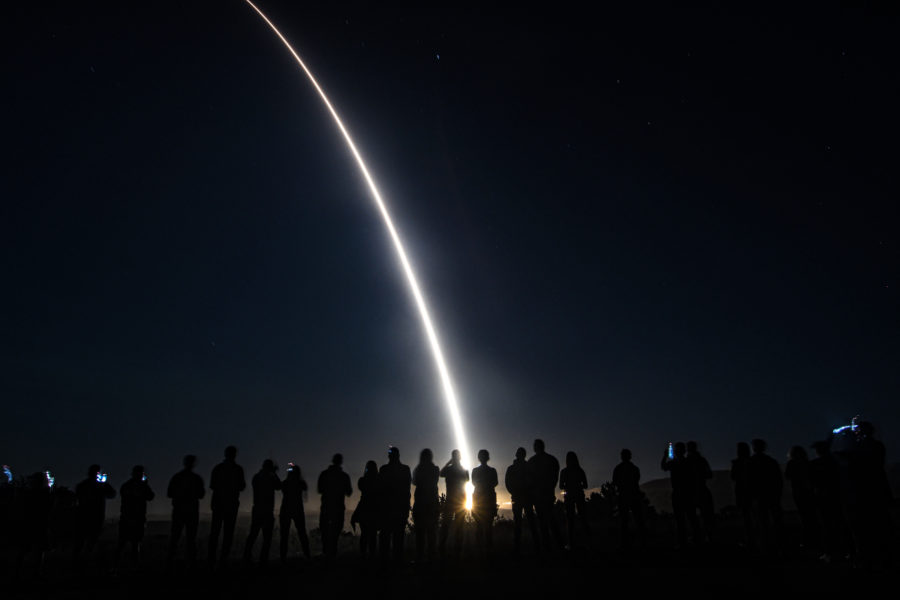A recent failed Minuteman III intercontinental ballistic missile test has led to new concerns about the age of America’s land-based nuclear arsenal.
“It has served our country well and we will continue to depend on it to deter nuclear war until the 2030s, but this week’s test is a stark reminder that nothing lasts forever,” Rep. Mike Rogers (R-Ala.), Chairman of the House Armed Services Committee, said in a statement released on Nov. 3. “We must modernize our aging nuclear deterrent and replace the Minuteman III missile—as well as the rest of our nuclear enterprise—with modern systems.”
An unarmed Minuteman III missile was terminated during a test launch from Vandenberg Space Force Base, Calif., due to an anomaly on Nov. 1.
While the Air Force is investigating to pinpoint the issue, Tim Ryan, Senior Resident Fellow at the Mitchell Institute for Aerospace Studies, said that he doesn’t believe the anomaly is linked to the age of the Minuteman system, suggesting it could have been caused by a variety of reasons.
Anomaly can represent any deviation or irregularity from the expected or projected behavior during the launch and testing process of the missile, which itself is an “extremely rigid and rigorous” regime.
Ryan emphasized that MM III technology remains reliable, as proven through regular flight tests conducted multiple times a year. The nuclear-capable missile has a range of 6,000-plus miles and can travel at approximately 15,000 miles per hour.
However, he added that other aspects of the weapon system, such as the silo, electronics, and warhead, are equally as old, and have been long neglected.
“As a whole, the weapon system is reliable. But it could use vital upgrades, just to be able to bring the weapon system up to date,” said Ryan.
The upcoming Sentinel missiles, which U.S. officials say will be easier to maintain and upgrade, are set to replace the 400 Minuteman IIIs in the continental U.S.
The Pentagon is accelerating the Sentinel tasks to meet the operational goal by Sept. 2030, as part of the nation’s broader modernization initiative of all three components of nuclear forces—air, land, and sea.
The Sentinel program is currently updating its integrated master schedule alongside Air Force and Office of the Secretary of Defense efforts to implement new acquisition strategies, an Air Force Spokesperson told Air & Space Forces Magazine.
The Air Force also contracted Lockheed Martin to produce customized reentry vehicle MK21A for the ICBM, expected to be completed by 2039.
The RV program has just entered the Engineering and Manufacturing Development (EMD) on Oct. 30, the spokesperson added.
However, challenges still exist regarding the timely delivery of the Sentinel system.
House Armed Services Committee Ranking Member Rep. Adam Smith (D-Wash.) and other members of Congress have previously questioned the necessity of simultaneous triad modernization, advocating for independent validation of the Air Force’s cost estimates for the Sentinel.
The Air Force also stressed its planning and operations of the project being significantly hindered by continuing resolutions. In October, the Air Force Nuclear Weapons Center said they face budget constraints that affect delivering necessary nuclear capabilities for daily deterrence due to these restrictions.
Ryan emphasized the importance of Congress prioritizing the nuclear modernization effort and passing a budget, which has yet to happen for the current fiscal year.
“They need to understand the impact of passing continuing resolutions on a program like Sentinel, and ensure consistent funding at the levels and timing that can make it a reality.”
He added that the launch results from Nov. 1 are not expected to affect future scheduled tests unless the analysis discovers a flight problem, which has never occurred in prior tests.
Multiple Minuteman III tests are slated for the upcoming year at Vandenberg Space Force base, as ICBM launches are planned years in advance.
